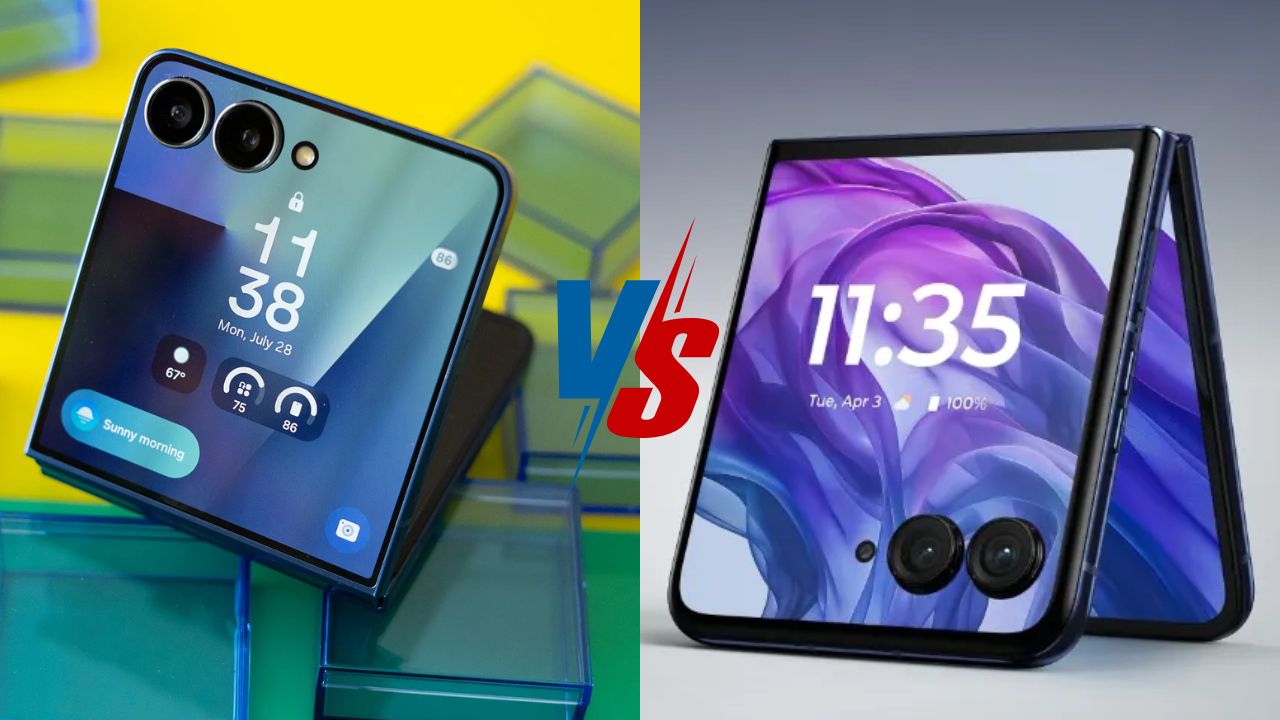The flip phone revolution is in full swing, and choosing between Samsung’s Galaxy Z Flip 7 and Motorola’s Razr Ultra 2025 isn’t easy. Both phones finally deliver what we’ve been waiting for – edge-to-edge cover screens that actually make sense. But which one deserves your hard-earned money?
Let’s break down everything you need to know to make the right choice for your lifestyle and budget.
The Price Reality Check
Here’s the first thing that’ll grab your attention: the Galaxy Z Flip 7 starts at $1,100 for 256GB storage, while the Motorola Razr Ultra begins at $1,300 for 512GB. That’s a $200 difference right off the bat, though you’re getting double the storage with the Motorola.
If you’re budget-conscious, Samsung clearly wins this round. But before you decide, let’s see what each phone brings to the table for that money.
Cover Screens: Samsung Finally Gets It Right
Size and Usability
Remember when Samsung’s flip phones had those tiny, almost useless cover screens? Those days are over. The Galaxy Z Flip 7 now sports a 4.1-inch edge-to-edge cover screen that’s actually bigger than the Razr Ultra’s 4.0-inch display, thanks to incredibly thin bezels.
Both phones let you do everything on the cover screen – reply to messages, scroll social media, take photos, and run apps. You’ll find yourself opening the phone less often, which is exactly what you want from a flip phone.
Refresh Rates
The Flip 7’s cover screen runs at 120Hz (smooth scrolling), while the Razr Ultra pushes 165Hz. In daily use, both feel incredibly smooth, but the Motorola has a slight edge if you’re really sensitive to display fluidity.
Performance: Where Motorola Flexes Its Muscles
Processing Power
This is where things get interesting. Samsung decided to skip the expensive Snapdragon 8 Elite chip and went with their own Exynos 2500 processor instead. Meanwhile, Motorola packed in the flagship Snapdragon 8 Elite.
For everyday tasks like texting, social media, and streaming videos, you won’t notice much difference. But if you’re into mobile gaming or intensive apps, the Razr Ultra will handle everything more smoothly.
Memory and Storage
The Razr Ultra comes with 16GB of RAM compared to the Flip 7’s 12GB. More RAM means better multitasking and fewer app reloads. However, both phones use the same fast UFS 4.0 storage, so file transfers and app loading feel snappy on both devices.
Design and Build Quality
Physical Dimensions
The Galaxy Z Flip 7 is the more compact option – it’s thinner (6.5mm vs 7.2mm), lighter (188g vs 199g), and not as tall when unfolded. If pocket space matters to you, Samsung wins.
Hinge Durability
Samsung’s hinge feels more robust and can hold the phone at steeper angles, which is great for hands-free video calls or watching content. The Motorola’s hinge works fine but doesn’t feel quite as sturdy.
Both phones have IP48 rating, meaning they can handle water but aren’t fully dust-proof. It’s progress, but we’re still waiting for complete dust protection on flip phones.
Camera Performance: Different Approaches, Similar Results
Main Camera Quality
Both phones use 50MP main cameras, but they process photos differently. The Razr Ultra tends to produce more natural-looking shots with deeper shadows and better contrast. The Galaxy Z Flip 7 brightens shadows more aggressively, giving that typical “smartphone look” that some people prefer.
For ultra-wide shots, the Motorola captures a slightly wider field of view and generally produces more engaging colors.
Selfie Game Strong
Here’s where flip phones shine – you can use the main camera for selfies thanks to the cover screen. Both phones excel at this, but the Motorola’s software is better at lighting up faces and adding contrast for more flattering results.
Battery Life: Motorola Takes the Lead
Battery Capacity
The Razr Ultra packs a substantial 4,700mAh battery compared to the Flip 7’s 4,300mAh. In real-world usage, the Motorola generally lasts longer, especially for web browsing and gaming.
Charging Speeds
This is where the difference becomes dramatic. The Razr Ultra charges at 68W wired and 30W wireless, while the Galaxy Z Flip 7 sticks to 25W wired and 15W wireless. If you’re always in a hurry, Motorola’s fast charging is a game-changer.
Keep in mind that you’ll need Motorola’s official charger to get the fastest speeds – third-party chargers won’t deliver the same performance.
Software and Updates: Samsung’s Long-Term Advantage
Update Support
Here’s a huge differentiator: Samsung promises 7 years of software updates for the Galaxy Z Flip 7, while Motorola only commits to 3 years for the Razr Ultra. If you plan to keep your phone for several years, Samsung’s longer support makes it a much better investment.
Software Features
The Galaxy Z Flip 7 supports Samsung DeX, which lets you connect to a monitor and use your phone like a desktop computer. It’s a niche feature, but incredibly useful for productivity enthusiasts. The Razr Ultra doesn’t have an equivalent feature.
Motorola adds an AI button that launches Perplexity Assistant, which some users might find handy for quick AI queries.
Which Phone Should You Choose?
Go with the Galaxy Z Flip 7 if:
- You want the best value for money
- Long-term software support matters to you
- You prefer a more compact design
- Samsung DeX sounds useful for your workflow
Choose the Motorola Razr Ultra if:
- You want the absolute best performance
- Fast charging is essential to your lifestyle
- You do a lot of mobile gaming
- You prefer more natural-looking photos
The Bottom Line
Both phones represent the best of what flip phones can offer in 2025. The Galaxy Z Flip 7 provides excellent value with its lower price, longer software support, and refined user experience. The Motorola Razr Ultra costs more but delivers superior performance and charging speeds.
Your choice ultimately depends on your priorities: savings and longevity with Samsung, or premium performance with Motorola. Either way, you’re getting a flip phone that finally makes sense in the modern smartphone world.
